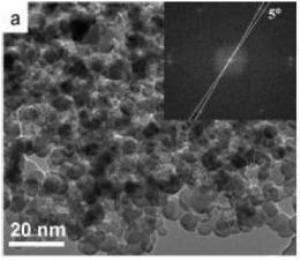Journal of the American Chemical Society, in its latest issue, has published a study done by research group, Dr. Vinay Gupta and coauthors from the Organic and Hybrid Solar Cell Group at the National Physical Laboratory located in New Delhi, India.
According to researchers, several studies have been done in the past on quantum dots that is used as a material that accepts electrons in photovoltaics. The properties such as effective multiple carrier generation, size-based optical response, and cost-saving features make quantum dots suitable for photovoltaic devices. However, researches conducted in the past reveals that several quantum dots are made up of toxic metals like lead and cadmium, which makes it unfit for applications in large-scale devices.
 A transmission electron microscopy image of the graphene quantum dots.
A transmission electron microscopy image of the graphene quantum dots.
On the contrary, researchers developed graphene quantum dots of 9 nm size that do not possess the same harmful characteristics, but exhibit similar electronic properties. Since graphene has a high-charge carrier generation that implies it can rapidly carry charges to electrodes ensuring minimum energy discharge and thereby improving the efficiency of the solar cell.
In this study, scientists discovered that graphene quantum dots (GQDs) combined with a conjugated polymer showed better characteristics when compared to graphene sheets combined with the same polymer.
According to Gupta, GQDs display qualities of being a good acceptor and hence can replace costly C60-based acceptors. This discovery holds significance for effective and cost-saving solar cells and organic light-emitting diodes (OLEDs) and their major benefits include flexibility, less weight, large-scale processing, less expensive, roll to roll manufacturing, and multiple usages, he added.
Fabrication of photovoltaic solar cells as well as OLEDs was done with GQD-based material, showing better performance in both the devices. Their findings reveal that GQD materials can be eco-friendly and more consistent than existing organic materials. Scientists are trying to combine GQDs with other polymers to improve devices’ performance further.